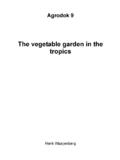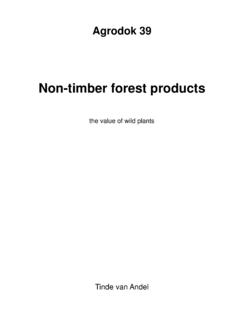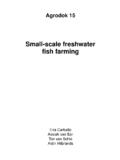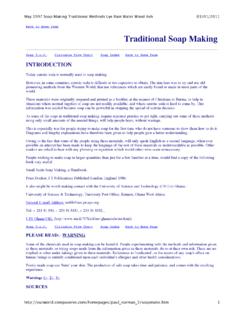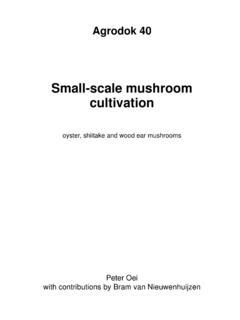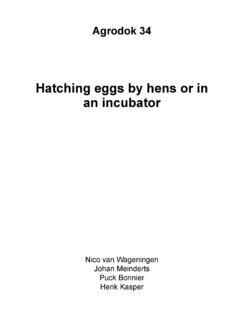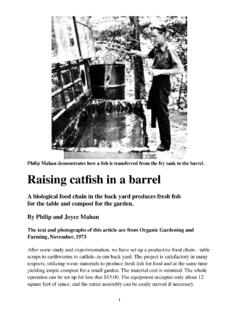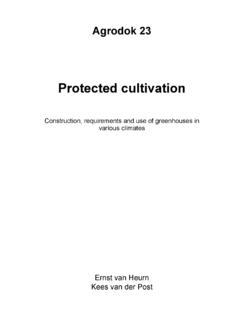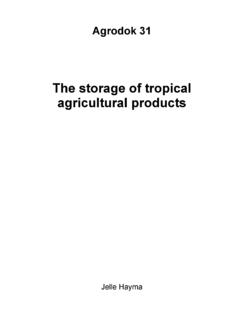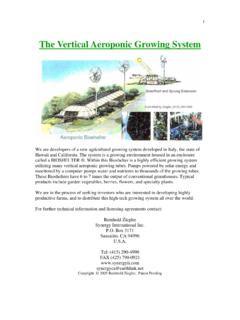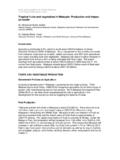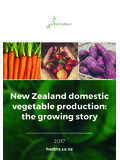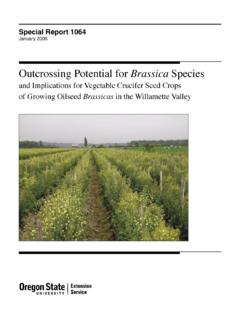Transcription of Nutritional Quality of Organic Versus Conventional …
1 THE JOURNAL OF ALTERNATIVE AND COMPLEMENTARY MEDICINEV olume 7, Number 2, 2001, pp. 161 173 Mary Ann Liebert, Quality of Organic Versus ConventionalFruits, Vegetables, and GrainsVIRGINIA WORTHINGTON, , , :To survey existing literature comparing nutrient content of Organic and conven-tional crops using statistical methods to identify significant differences and trends in the :Published comparative measurements of Organic and Conventional nutrient contentwere entered into a database for calculation. For each Organic -to- Conventional comparison, a per-cent difference was calculated:(organic2conventional) nutrients where there was adequate data, the Wilcoxon signed-rank test was used to iden-tify significant differences in nutrient content as represented by the percent difference. Meanpercent difference values were also calculated for each significant nutrient by study and by veg-etable for the most frequently studied vegetables.
2 The nutrient content of the daily vegetable in-take was calculated for both an Organic and Conventional : Organic crops contained significantly more vitamin C, iron, magnesium, and phos-phorus and significantly less nitrates than Conventional crops. There were nonsignificant trendsshowing less protein but of a better Quality and a higher content of nutritionally significant min-erals with lower amounts of some heavy metals in Organic crops compared to Conventional :There appear to be genuine differences in the nutrient content of Organic andconventional foods are required in a number ofalternative treatments, including severalalternative cancer therapies. It is widely as-sumed that any benefit derived from organicfoods is due to an absence of pesticide , prior to the widespread use of pes-ticides, those in the health care community whoadvocated Organic foods claimed that thesefoods contained a better arrangement of nutri-ents as a result of the superior soil managementand fertilization practices used by organicfarmers.
3 As a corollary, they cautioned thatfood grown with chemical fertilizers caused deteriorating health in animals and humans(Cheshire Panel Committee, 1939).Despite these warnings about the health ef-fects of chemical fertilizers and pesticides,farmers abandoned the labor-intensive prac-tices used in Organic agriculture in favor ofthese easier to use chemicals. Prior to WorldNutrikinetics, Washington, paper is an extension of work performed as part of doctoral dissertation at Johns Hopkins University, Balti-more, II, agricultural chemicals were virtuallyunused. But by 1995, more than 45 million tonsof chemical fertilizers and 770 million poundsof synthetic pesticides were used in agri-culture alone (Terry, 1999; Aspelin, 1999).Ninety-five percent (95%) of crops in theUnited States are now produced with chemicalfertilizers and pesticides ( Department ofAgriculture, National Agricultural StatisticalService, Agricultural Statistics Board, 2000),and producing crops using these chemicals hascome to be known as Conventional is evidence, however, that this majorchange in agricultural methods may not havebeen entirely benign from a Nutritional point ofview.
4 Coincident with the changes in agricul-tural practices, there have been recently iden-tified changes in the nutrient composition offresh fruits and vegetables. Four differentanalyses of and British nutrient contentdata have shown a decline in the vitamin andmineral content of fresh fruits and vegetablesover the last 60 years (Klein and Perry, 1982;Bergner, 1997; Mayer, 1997; Jack, 1998). Aver-age declines in nutrient content are shown inTable does agriculture affect nutrient com-position? Are agricultural chemicals responsi-ble for the decrease in nutrient content? A number of studies over the last 75 years haveaddressed the question of whether agriculturalchemicals and other agricultural methods in-cluding Organic farming affect nutrient question is still unresolved in part due tothe large amount of variability in agriculturaldata resulting from uncontrollable factors suchas rainfall and sunlight, which also influencenutrient content.
5 In addition, few existing stud-ies are exactly alike or even very similar asthere are differences in crops grown, fertiliza-tion methods used, storage methods if any, factors can make it hard to interpret datafrom such studies in any conclusive , given the relevance of this is-sue to both alternative medicine and to the foodsupply in general, it is still useful to take abroad view of the existing data. In that light,the purpose of this study is to examine all ofthe available comparisons of crops grown or-ganically with those produced conventionally,using computerized and statistical methods toidentify differences and analysis used all available studies thatcompared crops produced with Organic fertil-izer or by Organic farming systems to cropsproduced with Conventional fertilizers or farm-ing systems. This analysis focused on fertiliz-ers either alone or within farming systems be-cause fertility management is historically themost fundamental difference between organicand Conventional agriculture.
6 Studies of pro-duce from research plots and greenhouses,farm-gate produce, stored produce, and pro-duce purchased at markets were all there are insufficient data from anyone of these types of studies to draw mean-ingful conclusions, all of the data from the var-ious types were all, 41 studies were included. Table 2shows the 41 studies and the nutrients thatwere measured in each study. These 41 studiesreported the results of 22 replicated field trials,4 simple field trials, 4 greenhouse pot experi-ments, 4 market basket surveys, and 8 surveysof commercial farms or home growers. For 3studies, detailed methodology was unavail-able. In the majority of studies, data were col-lected over a time period of several years. Allunique comparative data were extracted fromthese 41 studies for this single comparison consisted of a single nu-trient in a single Organic fruit, vegetable or ce-real grain grown in one growing season WORTHINGTON162 TABLE1.
7 ANDBRITISHCROPSIN THELASTSIXTYYEARS* 1963 1992 Britain 1936 1987(13 fruits & (20 fruits & Mineralvegetables)20 vegetables)Calcium229219 Magnesium221235 SodiumN/A243 Potassium26214 Phosphorus21126 Iron232222 CopperN/A281N/A, not analyzed.* (Berginer, 1997) and British (Mayer, 1997) et al. XXXXX(1983)Barker (1975)XBessenich (1946)XBlanc et al. XXXXXXXXXXXXXX(1984)Brandt and XXXXB eeson (1951)Chang and XXXXXS alomon (1978)Clarke and XXXXXXXXXM errow (1979)Dlouhy (1977)XXXF ischer andXXRichter (1984)Hansen (1981)XXXXXXH arwood (1984)XKansal et al. (1981)XXXXXXXL airon et al. XXXXXXXXX(1984a)Lairon et (1984b)Lairon et (1984c)LeClerc et (1991)Linder (1973)XMader et al. XXXXX(1993)Miller and XXXXXXXXXXXDema (1958)Muramoto X(1999)Nilsson (1979)XXXXXXX(continued on page 164)Peavy and XXXXXXXXG rieg (1972)Pettersson (1983)XXXP feiffer (1951)XRauter andXWolkerstorfer(1984c)Reinken (1984)XXXXXXXXXS chudel et (1979)Schuphan (1974)XXXXXXXXXXXS hier et al.
8 (1984)XXSmith (1993)XXXXXXXXXXXXXXXXXXXXXXXXS topes et al. X(1988)Stopes et (1989)Svec et al. (1976)XXXXXT ermine et al. XXXXXXXX(1984)Termine et (1987)Vogtmann (1984)XXXXXXV ogtmann et (1984)Warman and XXXXH avard (1996)Warman andXXXXXXXXXXXXXXH avard (1997)Wolfson andXXShearer (1981)Worthington XXXXX(1996)AL, aluminum; Bo, boron; Ca, calcium; Cd, cadmium; Cl, chlorine; Co, cobalt; Cr, chromium; Cu, copper; Fe, iron; Hg, mercury; I, iodine; K, potassium; Li, lithium; Mg,magnesium; Mi, minerals; Mn, manganese; Mo, molybdenum; Na, sodium, Ni, nickel; P, phosphorus; Pb, lead; S, sulfur; Se, selenium; Si, silicon; Vn, vanadium; Zn, zinc;Nt, nitrates; Qt, protein quantity; Ql, protein Quality ; Ct, b-carotene; B1, vitamin B1; B2, vitamin B2; B3, vitamin B3; B5, vitamin B5; B6, vitamin B6; C, vitamin C; E, vitamin (continued)NutrientStudyALBoCaCdClCoCrCu FeHgIKLiMgMiMnMoNaNiPPbSSeSiVnZnCtB1B2B3 B5B6 CENtQnQlcompared to the same nutrient in the same con-ventionally grown crop grown in the same sea-son, , mg of zinc in 100 g of organiccabbage compared to mg in an equalamount of Conventional cabbage, both grownin the summer of 1986.
9 Some studies reportedpooled comparisons that averaged the resultsfor more than 1 year or more than one comparisons were included in the analy-sis when single comparisons were not avail-able. All comparisons were used as total of 1,297 comparisons were consideredfor analysis. Of this total, 57 comparisons camefrom 4 studies that did not report the numeri-cal nutrient content measurements but insteadmade statements such as the products of theconventional and Organic plots did not differin content or otherwise presented the infor-mation in a nonnumeric way (Nilsson, 1979;Harwood, 1984; Reinken, 1984; Termine et al.,1984). Because the majority of these 57 com-parisons indicated no difference in nutrientcontent, these comparisons were excludedfrom determinations of statistical significanceand other computations. The remaining 1,240comparisons were entered into a database forcalculation, encompassing 35 vitamins andminerals as well as protein Quality and each comparison, a percent differencewas computed as percent difference numbers indicate thepercent more or less of a nutrient found in theorganic crop as compared to the conventionalcrop.
10 The percent difference was used to pro-duce descriptive statistics and in tests of statistical significance of the differencein nutrient content between Organic and con-ventional crops was calculated for nutrientswhere there were adequate data. Most nutri-ents were measured in 3 or fewer studies anda small number of comparisons. The remaining12 nutrients were measured in 8 or more stud-ies with 39 or more comparisons: calcium, mag-nesium, potassium, sodium, zinc, copper, manganese, iron, phosphorus, vitamin C, b-carotene, and nitrates. The statistical signifi-cance of the difference was computed for these12 nutrients using the Wilcoxon signed-ranktest (Kohler, 1988).The vegetables in which each nutrient wasmeasured are shown in Table 3. Five vegeta-bles were more frequently studied than otherOrganic Value2 Conventional Value}}}}} Conventional ValueNUTRITIONAL Quality AND AGRICULTURAL PRACTICES165 TABLE3. THETWELVEMOSTSTUDIEDNUTRIENTSANDTHEVEGET ABLES INWHICHTHEYWEREMEASUREDN utrientVegetablesCalciumBeet root, cabbage, carrot, celeriac, kale, leek, lettuce, pepper, potato, spinach, tomato, turnip, apple, pear, currant, corn, wheatCopperCabbage, carrot, celeriac, leek, lentil, lettuce, pepper, potato, spinach, turnip, apple, pear, currant, barley, brown rice, corn, wheatIronCabbage, carrot, celeriac, leek, lentil, lettuce, pepper, potato, spinach, tomato, turnip, apple, pear, currant, barley, brown rice, corn, wheatMagnesiumBeet root, cabbage, carrot, celeriac, kale, leek, lettuce, pepper, potato, spinach, tomato, turnip, apple, pear, currant, corn, wheatManganeseCabbage, carrot, celeriac, leek, lettuce, pepper, potato, spinach, turnip, apple, pear, corn, wheatPhosphorusBeet root, cabbage, carrot, celeriac, kale, leek, lettuce, pepper, potato, spinach, tomato, turnip, apple, pear, currant, corn, wheatPotassiumBeet root.
